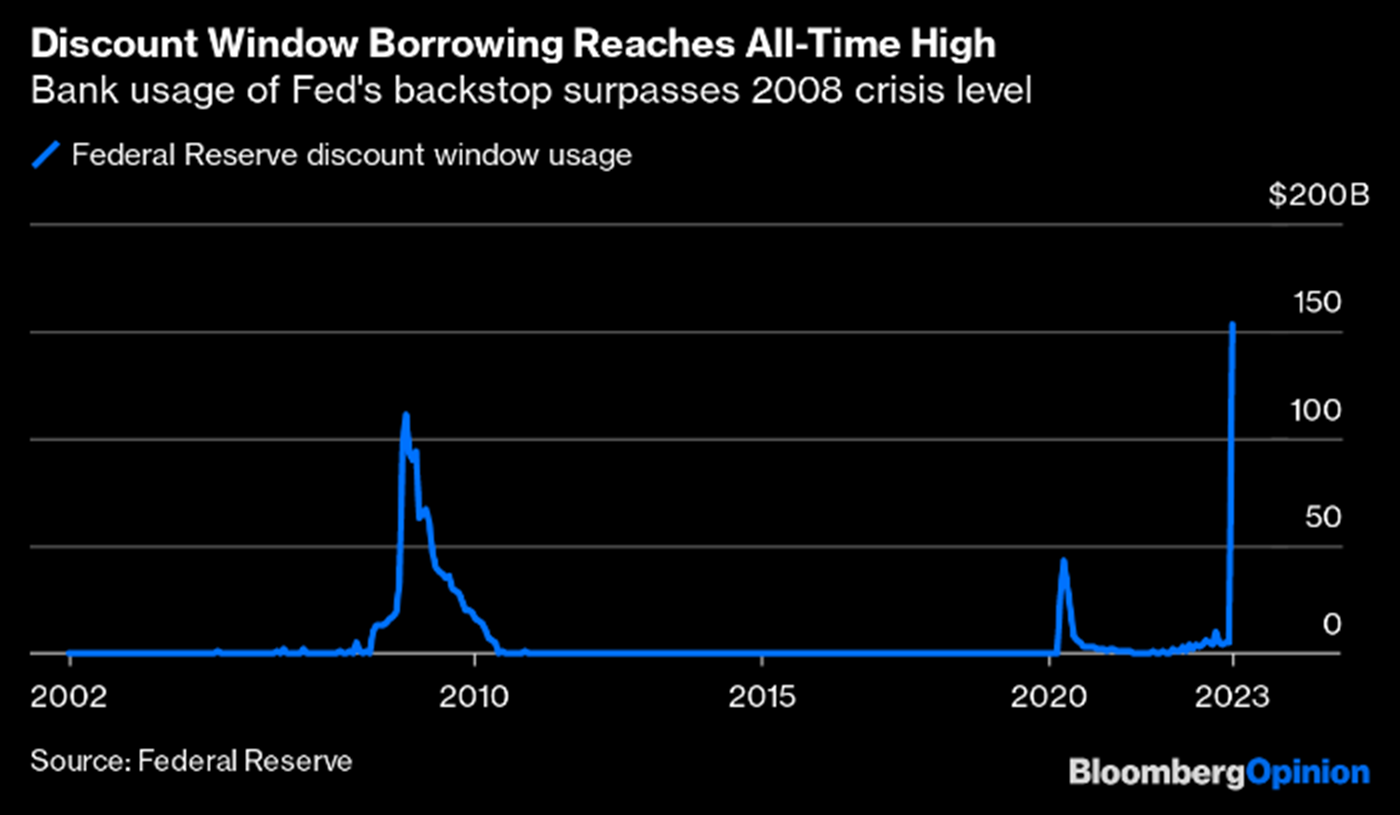Risk Control vs. Fundamentals
March 17, 2023
Read Time 2 MIN
Fed Policy Rate
The market is still trying to evaluate the effectiveness of the U.S. Federal Reserve’s (Fed’s) liquidity reprieve for banks. A Bloomberg chart making rounds this morning shows a huge spike in banks’ discount window borrowing at the Fed (see below), but some bank credit default swaps (CDS) widened again. A big question is whether the Fed will reaffirm the “new normal” of lower interest rates at next week’s meeting, or follow the European Central Bank (ECB) hawks and prioritize inflation. The expectations are mixed. The implied probability of the full 25bps hike is still around 70%, and the implied peak rate remains below 5%. Today’s softer than expected University of Michigan survey – including short- and long-term inflation expectations – points to even more uncertainty in the next few days.
China Recovery
Most emerging markets (EM) are watching the current situation from the sidelines (policy-wise), but China decided to respond with a broad-based 25bps cut in its reserve requirement ratios1 (RRR) – in addition to liquidity injections through other facilities. The RRR cut was not entirely unexpected – short rates have been grinding higher for some time now, which is not an ideal backdrop for the nascent recovery – and the move does not contradict the State Council’s “supportive yet restrained” policy objectives. The timing, however, suggests that risk prevention played a big part.
EM Reaction to the Banking Crisis
China’s reaction is important because a number of EMs – especially in in Asia – are arguably more correlated with the reopening/rebound narrative than with the Fed. This reflects not only the “growth” links, but also the fact that inflation had peaked at lower levels than in EM peers, putting less tightening pressure on central banks. The EMFX price action in the past week illustrates the “anti-Fed correlation” point quite well – Asian currencies pretty much ignored the banking mini-crisis in developed markets (DM), rising against the U.S. dollar. Other important policy litmus tests in EM include rate-setting meetings in Brazil, Mexico, Colombia, Thailand and South Africa – all these will take place after the Fed reveals its policy objectives. Stay tuned!
Chart at a Glance: U.S. Fed’s Big Response to Banking Mayhem

Source: Federal Reserve
1The “reserve requirement ratio” (RRR) or cash reserve ratio (CRR) is the percentage of customer deposits and other liquid assets that commercial banks must store, within its own institution or with the central bank.
Related Topics
Related Insights
February 26, 2024
January 04, 2024
October 27, 2023
PMI – Purchasing Managers’ Index: economic indicators derived from monthly surveys of private sector companies. A reading above 50 indicates expansion, and a reading below 50 indicates contraction; ISM – Institute for Supply Management PMI: ISM releases an index based on more than 400 purchasing and supply managers surveys; both in the manufacturing and non-manufacturing industries; CPI – Consumer Price Index: an index of the variation in prices paid by typical consumers for retail goods and other items; PPI – Producer Price Index: a family of indexes that measures the average change in selling prices received by domestic producers of goods and services over time; PCE inflation – Personal Consumption Expenditures Price Index: one measure of U.S. inflation, tracking the change in prices of goods and services purchased by consumers throughout the economy; MSCI – Morgan Stanley Capital International: an American provider of equity, fixed income, hedge fund stock market indexes, and equity portfolio analysis tools; VIX – CBOE Volatility Index: an index created by the Chicago Board Options Exchange (CBOE), which shows the market's expectation of 30-day volatility. It is constructed using the implied volatilities on S&P 500 index options.; GBI-EM – JP Morgan’s Government Bond Index – Emerging Markets: comprehensive emerging market debt benchmarks that track local currency bonds issued by Emerging market governments; EMBI – JP Morgan’s Emerging Market Bond Index: JP Morgan's index of dollar-denominated sovereign bonds issued by a selection of emerging market countries; EMBIG - JP Morgan’s Emerging Market Bond Index Global: tracks total returns for traded external debt instruments in emerging markets.
The information presented does not involve the rendering of personalized investment, financial, legal, or tax advice. This is not an offer to buy or sell, or a solicitation of any offer to buy or sell any of the securities mentioned herein. Certain statements contained herein may constitute projections, forecasts and other forward looking statements, which do not reflect actual results. Certain information may be provided by third-party sources and, although believed to be reliable, it has not been independently verified and its accuracy or completeness cannot be guaranteed. Any opinions, projections, forecasts, and forward-looking statements presented herein are valid as the date of this communication and are subject to change. The information herein represents the opinion of the author(s), but not necessarily those of VanEck.
Investing in international markets carries risks such as currency fluctuation, regulatory risks, economic and political instability. Emerging markets involve heightened risks related to the same factors as well as increased volatility, lower trading volume, and less liquidity. Emerging markets can have greater custodial and operational risks, and less developed legal and accounting systems than developed markets.
All investing is subject to risk, including the possible loss of the money you invest. As with any investment strategy, there is no guarantee that investment objectives will be met and investors may lose money. Diversification does not ensure a profit or protect against a loss in a declining market. Past performance is no guarantee of future performance.
PMI – Purchasing Managers’ Index: economic indicators derived from monthly surveys of private sector companies. A reading above 50 indicates expansion, and a reading below 50 indicates contraction; ISM – Institute for Supply Management PMI: ISM releases an index based on more than 400 purchasing and supply managers surveys; both in the manufacturing and non-manufacturing industries; CPI – Consumer Price Index: an index of the variation in prices paid by typical consumers for retail goods and other items; PPI – Producer Price Index: a family of indexes that measures the average change in selling prices received by domestic producers of goods and services over time; PCE inflation – Personal Consumption Expenditures Price Index: one measure of U.S. inflation, tracking the change in prices of goods and services purchased by consumers throughout the economy; MSCI – Morgan Stanley Capital International: an American provider of equity, fixed income, hedge fund stock market indexes, and equity portfolio analysis tools; VIX – CBOE Volatility Index: an index created by the Chicago Board Options Exchange (CBOE), which shows the market's expectation of 30-day volatility. It is constructed using the implied volatilities on S&P 500 index options.; GBI-EM – JP Morgan’s Government Bond Index – Emerging Markets: comprehensive emerging market debt benchmarks that track local currency bonds issued by Emerging market governments; EMBI – JP Morgan’s Emerging Market Bond Index: JP Morgan's index of dollar-denominated sovereign bonds issued by a selection of emerging market countries; EMBIG - JP Morgan’s Emerging Market Bond Index Global: tracks total returns for traded external debt instruments in emerging markets.
The information presented does not involve the rendering of personalized investment, financial, legal, or tax advice. This is not an offer to buy or sell, or a solicitation of any offer to buy or sell any of the securities mentioned herein. Certain statements contained herein may constitute projections, forecasts and other forward looking statements, which do not reflect actual results. Certain information may be provided by third-party sources and, although believed to be reliable, it has not been independently verified and its accuracy or completeness cannot be guaranteed. Any opinions, projections, forecasts, and forward-looking statements presented herein are valid as the date of this communication and are subject to change. The information herein represents the opinion of the author(s), but not necessarily those of VanEck.
Investing in international markets carries risks such as currency fluctuation, regulatory risks, economic and political instability. Emerging markets involve heightened risks related to the same factors as well as increased volatility, lower trading volume, and less liquidity. Emerging markets can have greater custodial and operational risks, and less developed legal and accounting systems than developed markets.
All investing is subject to risk, including the possible loss of the money you invest. As with any investment strategy, there is no guarantee that investment objectives will be met and investors may lose money. Diversification does not ensure a profit or protect against a loss in a declining market. Past performance is no guarantee of future performance.

